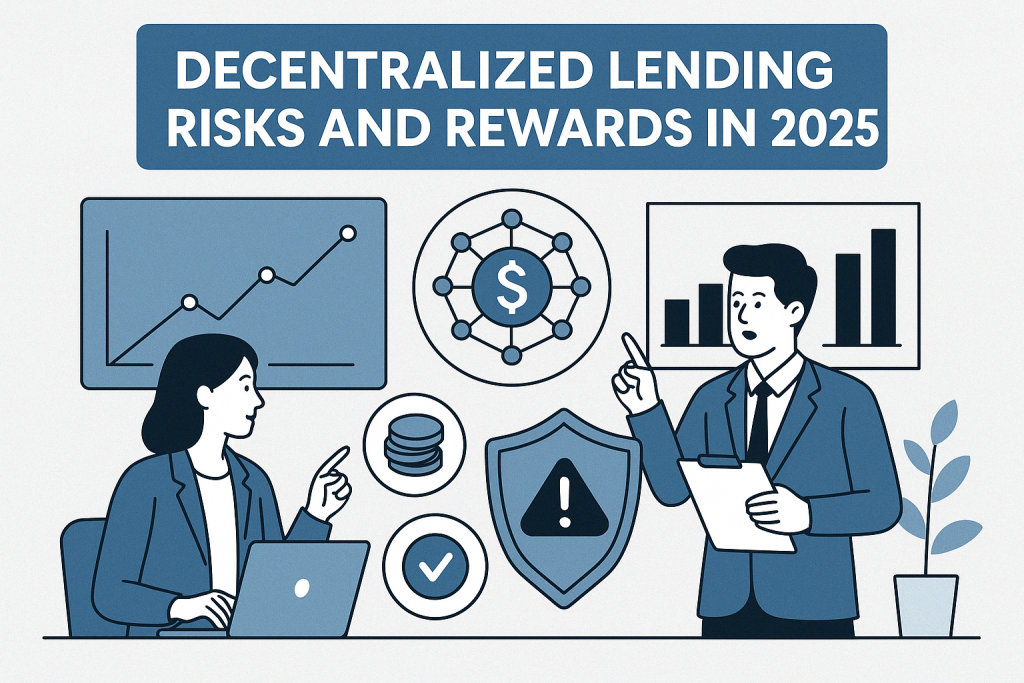📌 Hook: $2 Billion Lost or Earned — Welcome to the World of DeFi Lending
In 2024 alone, over $2.1 billion was borrowed through decentralized lending protocols — but nearly $280 million was lost to liquidations, protocol failures, or smart contract bugs. As we step into 2025, decentralized finance (DeFi) is no longer just an experiment — it’s a global capital engine.
But what lies beneath the surface of those sky-high yields?
This in-depth guide breaks down the real risks and rewards of decentralized lending, drawing from data, expert predictions, and real-world case studies — so you can navigate DeFi with clarity and confidence.

🔍 What Is Decentralized Lending?
Decentralized lending refers to peer-to-peer loans facilitated by smart contracts on blockchain networks, removing the need for banks or centralized platforms. Platforms like Aave, Compound, and Spark Protocol let users:
- ✅ Lend assets to earn interest
- ✅ Borrow assets by collateralizing crypto
- ✅ Participate in money markets without intermediaries
All this happens without KYC, 24/7, and programmatically enforced via code.
⚖️ The Rewards: Why People Use DeFi Lending
1. 🚀 High-Yield Opportunities
APYs on lending can reach 5–15%+, especially on volatile or emerging assets. Users earn passive income on idle tokens, including stablecoins.
Example:
- USDC on Spark Protocol (2025 average): 7.1%
- ETH lending on Aave: 5.3%
2. 🏦 Instant Liquidity Without Selling
Need funds but don’t want to sell your crypto and trigger taxes or lose upside? DeFi lets you borrow stablecoins by collateralizing ETH, BTC, or LSTs, maintaining market exposure.
3. 🌍 Global Accessibility
No banks. No paperwork. No borders. Anyone with a wallet can participate. This opens credit access to unbanked populations and Web3-native businesses.
4. 🛠️ Programmable Finance
Smart contracts allow modular products like auto-repaying loans, undercollateralized protocols (like Gearbox), and even social-based credit scoring.
🔥 The Risks: What You Might Lose (and How)
1. 🧨 Smart Contract Vulnerabilities
- DeFi protocols are only as safe as their code.
- Exploits like re-entrancy, oracle manipulation, and flash loan attacks can drain millions.
Case Study:
In 2024, the Hundred Finance protocol was exploited for $7.4 million on Optimism via a price manipulation bug in their oracle setup.
2. 📉 Liquidation Risk
If your collateral drops below a threshold, your position can be forcibly liquidated — often with penalty fees.
Example:
- A borrower deposits $10,000 in ETH and borrows $6,000 in DAI.
- ETH price drops 20% overnight.
- Smart contracts trigger a liquidation, possibly with 10%+ fees.
3. 🏗️ Protocol Failures or Governance Attacks
Even well-known protocols can fail:
- Compound accidentally issued excess rewards due to a governance bug.
- DAO takeovers have occurred via flash loan voting.
4. 🧊 Illiquidity and Peg Risks
- Low liquidity pools may lead to high slippage during withdrawals.
- Lending stablecoins like UST or aUSD exposed users to total loss after depegs.
5. 🛑 Regulatory Uncertainty
Many jurisdictions still view DeFi as a grey zone. In 2025, several countries are exploring “DeFi KYC mandates” that may impact participation and front-end access.
🧪 Real-World Example: AAVE Lending Walkthrough
- Alice deposits $10,000 USDC to Aave and earns 5.2% APY.
- Bob deposits $20,000 ETH as collateral, borrows $12,000 USDC at 6.1%.
- Aave smart contracts maintain solvency with a collateral ratio buffer (e.g., 80%) and liquidation bots.
If Bob’s ETH drops too far, his loan is liquidated — Alice still gets paid.
📈 2025 Trends in Decentralized Lending
| Trend | What’s Changing in 2025 |
|---|---|
| LSTs as Collateral | ETH liquid staking tokens dominate |
| Permissioned DeFi | Institutional lending pools emerging |
| Real-World Assets (RWA) | On-chain loans backed by invoices, T-bills |
| AI Risk Engines | AI-powered liquidation and scoring |
| Cross-Chain Lending | Interoperable loans via LayerZero, Axelar |
✅ Tips to Maximize Rewards and Minimize Risk
- Only use audited protocols (check CertiK, DeFiSafety ratings)
- Diversify across platforms (don’t park all funds in one vault)
- Avoid volatile collateral (prefer ETH, stables)
- Monitor your health factor daily (use tools like DeFi Saver)
- Be ready to top up or repay during volatile markets
🔗 Internal Link Recommendations
(你可以将以下文章标题改为你网站现有内容链接锚文本)
- 🛠️ [Beginner’s Guide to Using Aave Safely]
- 🧠 [What Is Liquid Staking and Why It Matters]
- 🔒 [Top 10 DeFi Security Practices You Must Follow]
❓ FAQ: Decentralized Lending in 2025
Q1: Is decentralized lending safe?
It can be — if you use audited protocols, conservative borrowing ratios, and monitor your collateral regularly. Risk is ever-present, especially with newer tokens.
Q2: What’s the difference between DeFi lending and CeFi?
DeFi lending is non-custodial, transparent, and operates via smart contracts. CeFi platforms (like Nexo, Celsius) require user trust and can freeze withdrawals.
📌 Final Thoughts: Know the Risk, Earn the Reward
DeFi lending offers freedom, yield, and financial innovation — but also demands responsibility. There are no bailouts, no customer support, no margin calls.
In 2025, DeFi lending is maturing, with protocols layering on AI risk engines, institutional-grade compliance, and real-world collateral models. But the core truth remains:
💡 You are your own bank. Learn the system — or risk being liquidated by it.
✅ Next Steps
- Try lending on a testnet like Aave Goerli
- Set alerts with tools like DeFi Saver, Instadapp, or Tenderly

